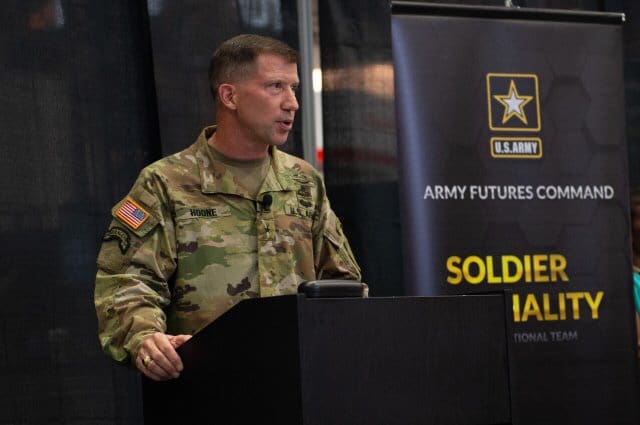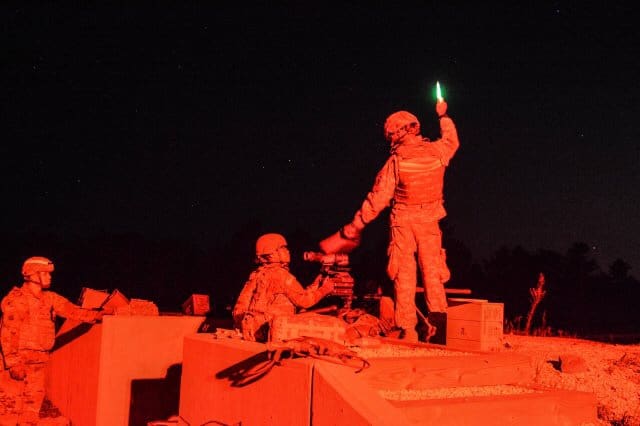WASHINGTON — The Army is slated to release the newest Enhanced Night Vision Goggle-Binocular to a select number of combat units sometime in fiscal year 2019, according to the Soldier Lethality Cross-Functional Team officials.

BG David Hodne, the Soldier Lethality Cross-Functional Team director, spoke about the Soldier Lethality team’s progress during the Association of the U.S. Army’s Annual Meeting and Exposition Oct. 9, 2018.(Photo Credit: US Army photo by Devon L. Suits)
The new ENVG-B has both night vision and thermal-sensing capabilities and “stereoscopic binocular depth perception,” providing Soldiers with an illusion of depth on a flat image, officials said.
According to 82nd Airborne Division Soldiers who field-tested the new technology, the new ENVG-B is a “game changer” providing Soldiers with a unique advantage against an adversary, said Brig. Gen. David Hodne, Soldier Lethality CFT director, during the Association of the U.S. Army’s Annual Meeting and Exposition, Oct. 9.
Soldiers testing the new device had a 100 percent improvement in weapons qualifications using that ENVG-B, along with a 300 percent increase in detection of targets in day and night environments, and a 30 to 50 percent decrease in the time taken to shoot a target, Hodne added.
Over the next three years, the Army is scheduled to field about 10,000 ENVG-B systems, according to Brig. Gen. Anthony Potts, the program executive officer in charge of PEO-Soldier. U.S. Army Forces Command has yet to finalize the list of units that will be among the first to receive the new ENVG-B.
Aside from the new night binoculars, the Army will also field the new ENVG version 3 in fiscal year 2019, he said.
Both devices will incorporate a wireless system that connects the goggles to a Soldier’s rifle sites, Potts explained. Through testing, Soldiers employing the ENVG version 3 “rapid target acquisition” capability have seen a 100 percent increase in first-time target engagement.

US Army Reserve SGT Gordon Massiah, Task Force Ultimate cadre, signals to the tower with a chemical luminescent stick at night-fire qualification during Operation Cold Steel II, hosted by U.S. Army Civil Affairs and Psychological Operations Command (Airborne), Aug. 7, 2018 at Joint Base McGuire-Dix-Lakehurst, N.J. The Army is slated to release the newest Enhanced Night Vision Goggle-Binocular to a select number of combat units sometime in fiscal year 2019. (Photo Credit: US Army photo by SPC Brianna Saville )
REQUEST FOR A COMMON CARTRIDGE
Back in July, the Army awarded an opportunity contract to five companies to develop prototypes for the Army’s Next Generation Squad Automatic Rifle System. The new system is said to replace the M249 squad automatic weapon serving in the automatic riflemen role.
Prototypes from the new weapon system are slated to be evaluated sometime in June 2019, Potts added.
“Much of this effort is informed by the findings of the 2017 Small Arms Configuration Study. Previously, Probability of Hit drove a lot of our requirements,” said Hodne. “But now, [the Army is] looking at energy — at range. It is one of the critical factors that will define the next generation squad weapons, both the automatic rifle and the rifle.”
Coinciding with the new squad rifle system, PEO-Soldier recently released a “draft Prototype-Opportunity Notice” to help develop a 6.8mm common bullet cartridge, Potts added. The goal is to have lethal effects on targets beyond 300 meters. The Phase II Prototype Opportunity will ask vendors to propose an automatic rifle, a rifle and a common cartridge.
“There’s a great logistics support function to having a common cartridge on the battlefield,” Potts said. “From an engineering perspective … if you’re going to optimize a cartridge, you want the engineers that are developing these weapons to be able to optimize both concurrently.”
Story by Devon L. Suits


This is a win for Joe- Good job, Army.
Great stuff, that ENVG-B is going to be awesome. Also- is that the Hot weather/tropical OCP ACU that BG Hodne is wearing? Noting the slant of the pockets and the lack of breast pockets. I wish that was widely available.
thermal + night vision overlay with wireless sight integration will reduce the need for ir laser signature and enhance stealth and surprise. although it will add to the power draw and battery weight, this is a good development and hopefully can be provided to more units in the future.
I’m not an electo engineer, but “wireless integration” of ANYTHING, to include this goggle-to-sight connection, implies by it’s very nature a detectable/jammable/targetable electronic signature being emitted by each and every soldier carrying the system.
It might be only a very low-powered signal…but the enemy is not always a bunch of low-tech primitives.
Agree with everything here. Though a possible solution for that could be a system that’s flexible enough to allow both wireless operation and wired. Usually ends up as more of a compromise since you add components to support both wired and wireless.
Is the ENVG-B basically a PSQ-36?
seems to be, but the ENVG-B seems to lack the same controls as the PSQ.
the PSQ only projects the thermal channel to one eye, perhaps the ENVG-B thermal channel uses both eyes?
other than that, the ENVG-B seem more streamlined and lighter, but looks can deceive.
cool beans anyways, good thing if its gonna trickle down to the grunt, not just the coolguys
Thanks.
I found a picture of the ENVG-B on Insight’s site. It does look a little more streamlined, but it looks like it uses the same, or at least similar, mounting/power system as the PSQ-20/ENVG. I see that as a weakness versus using the battery pack and cable used with the PVS-31, GPNVG, and PSQ-36. If Big Army is concerned about a cable running from back to front of the helmet, they should a) get over it or b) tuck it under the helmet cover.
The ENVG-B,AN/PSQ-36 has been around since 2013-2014ish. Why are they only NOW talking about fielding these in big numbers?
https://www.overtdefense.com/2018/10/15/l3-envg-b-night-vision-goggles-u-s-army/
https://tnvc.com/shop/l-3-anpsq-36-fgs/